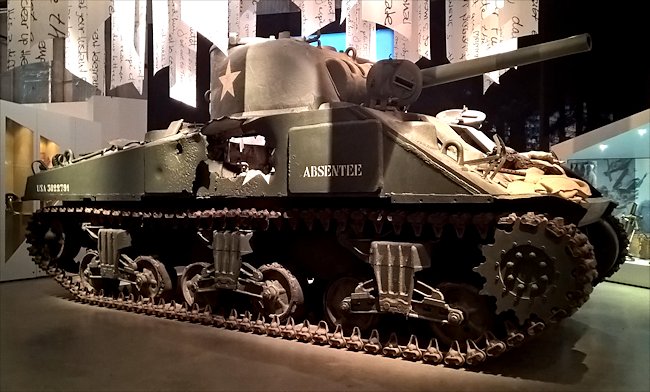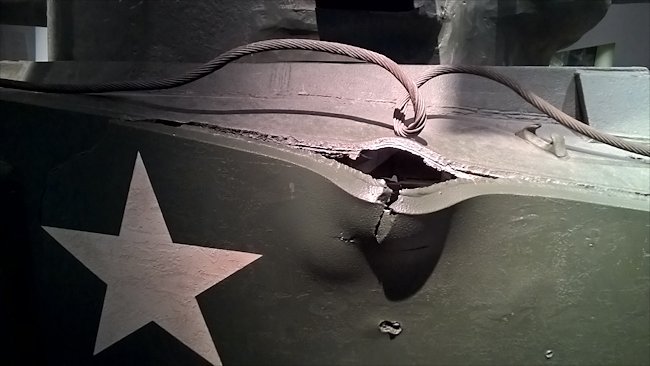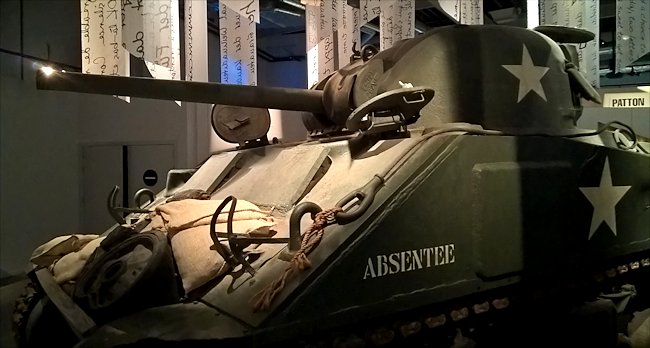Bastogne M4 Sherman Tanks
There are two Surviving World War II M4 Sherman tanks that can be seen at the Bastogne War Museum in Belgium.

This surviving World War 2 M4 Sherman tank in the Bastogne War Museum in Belgium has severe battle damage to its left side.
This American Sherman tank was one of thousands produced during WW2. It has the standard short barreled medium velocity 75mm M3 gun with a welded chassis and cast metal turret. When this version of the Sherman was first introduced in 1942 in North Africa it could easily knock out any German tank. As technology progressed and the German panzers were upgraded with better guns and armour, the short barreled 75mm Sherman tank was out classed by the opposition. It had to get very close to enemy tanks and fire at their weak spots in the side and rear. It won tank v tank engagements because of the high volume of tanks produced by American factories. They could over whelm a battlefield and win the day by superiority in numbers, even though suffering heavy losses.
Location
The Bastogne War Museum can be found at 5 Colline du Mardasson just north east outside Bastogne city centre. It is open at 9.30 am and close at 6pm (last entry 4pm) all week except Monday when the Museum is closed. It is also closed during January. In July and August it is open for an extra hour until 7pm (last entry 5pm). It is next to the star shaped American Liberators Memorial also known as the Mardasson Memorial. It honours the memory of American soldiers wounded or killed during World War II's Battle of the Bulge.

Shell damage on the M4 Sherman tank in the Bastogne War Museum
Six Sherman tanks hit near Manhay during the Battle of the Bulge
On Christmas Eve, 24th of December 1944, German armoured units were advancing on the village of Manhay during their winter offensive in the Belgium Ardennes that was later to be known as the Battle of the Bulge.
The American units in position around the village tried to stop the advance by setting up a roadblock on the minor road north of the village of Odeigne. It was manned by a company of the 40th Tank Battalion and men of the 48th Armoured Infantry Battalion.
Whilst the Americans were checking out a mysterious column approaching their position from the South, which turned out to be a detachment from the US 3rd Armoured Division, they failed to notice German Panzer Grenadier's sneaking up to their location.

Preserved M4 Sherman tank in the Bastogne War Museum
Suddenly Panzerfaust rockets blasted through the nearby woods. Within a few minutes six M4 Sherman tanks have been disabled. Two of the six damaged Shermans managed to limp towards American lines supported by the last one of the tank company that had not been damaged.
Tank crews not only had to look out for other enemy tanks and anti-tank guns, but they had to pay particular attention to infantry carrying handheld anti-tank rockets that could be fatal. They were relatively safe from these weapons in open countryside, but in villages, towns and cities, where soldiers could use the buildings to advance with in firing range, tank crews had to be particularly vigilant.
British Shermans in the Ardennes
According to Hollywood and many Belgium Museums the British did not take part in the Battle of the Bulge. This is not try. They stopped the Germans crossing the River Meuse and then took the fight to the Germans, with the help of the RAF bombers and ground attack aricraft like the Typhoon. This is a story of the first British tank engagement in the Battle of the Bulge:-
Already the massive RAF and USAF bombing attacks to the Germans' rear were paying off. Early on Christmas Eve December 1944 the Allied radio interception services had picked up a radio conversation coming from commanders of the 2nd Panzer point, asking whether they had captured any fuel during the night as they advanced steadily on Celles. A little later, as daylight came, Belgian gendarmes following the German drive, and reporting to the gendarmerie at Marche over the local telephone network, confirmed this. They had spotted 2nd Panzer Panthers passing by and each Panther had been towang three trucks out of fuel.
All the same, von Manteuffel's tanks were still advancing and coming closer to the bridging sites across the River Meuse. They were desperate to find fuel and get across the river. Waiting for them were the British. Above the fir-tipped peaks of the hills. The black shadows of the night were disappearing rapidly across the snowbound fields.
The first Panther drove into view. It was alone. It was tempting any unseen gunner to take a shot at it and give the enemy position away. None came. The forty-five-ton German tank rattled ever closer to the hidden British. Its long, overhanging gun swung slightly from left to right like the ugly snout of some primeval monster. The 'Tommies' were out there somewhere, but where exactly? The Germans would soon find out.
In the freezing box of his hull-down Sherman, Sgt 'Geordie' Probert snored on together with the other four men of his crew. Little did they realize that they were fated to fire the first shot of the British participation in the Battle of the Bulge. Suddenly they came to life. All of them had heard the noise. There was no mistaking 'the sound of straining engines and the clank of tank tracks'. It was a tank .. tanks were heading in their direction and the only armoured vehicles to their front were German.
Horrified, 'Geordie' Probert opened his eyes and peered out through the armoured slit of the Sherman's turret. A long, slow line of German vehicles was rolling along the valley road below. He yelled an order to the gunner next to him, checking whether the shell that they had loaded was armour piercing. It was, but the gunner, as he hurried to fire, swinging the turret round to get a bearing on the sinister German column below, forgot to adjust his range. He brought his sight round until a German Puma armoured car was neatly cross-sectioned in the calibrated aiming circle of glass. He fired. The Sherman trembled. Next to him, Probert could feel the shock wave of the solid AP shell zipping towards the unsuspecting Germans.
The next moment, halfway down the column, a truck slowed to a sudden stop. For what seemed an eternity, nothing happened. The tanks in the lead ground on in low gear, as if they weren't even aware that they had been attacked. Suddenly, the truck burst into angry scarlet flame, tinged at the edges with black, oily smoke. They had hit an ammo truck. An instant later, exploding ammunition started to zig-zag crazily in different directions. A petrol truck followed, disappearing in a mass of flame and blocking the road for those vehicles following it.
'Adjust the bleeding range,' Probert yelled frantically in his thick North Country accent. The gunner did. Now better organized and knowing that they were in an excellent defensive position, proof even against a Panther at that range, the crew settled down to deal methodically with the stalled German column. First Probert's men tackled the easy targets. An elderly Mark IV tank was struck and started to burn; its amour wasn't as thick as that Of the Panther.
A half-track packed with panzer grenadiers followed. Everywhere dead and dying grenadiers lay on the icy cobbled road writhing in their final frenzied agonies. Soon after that a scout car followed. Both its rear tyres were deflated and thick white smoke was pouring from its engine cowling. Now Probert's crew were transformed from their normally staid selves. They had become like primeval men, carried away by the heady excitement of the battle — the need to kill.
But the enemy was now reacting, as a couple of the stalled panzers fired smoke, a ponderous German self-propelled gun waddled out of the coloumn. It was an Elefant SPG, carrying a huge 88mm gun whose shell could go through the Sherman's inch thick frontal armour like a hot knife through butter. Now it started to labour up the incline towards the Sherman's position.
Probert's crew shook off their mood of wild, unreasoning excitement. It was as if they had been abruptly doused in ice-cold water. Hastily, fumbling through the Sherman's many gears, the driver backed off while they still had a chance. Probert and his men had done enough for this morning. Elsewhere others of the 3 RTR's Shermans took up the challenge. A second Mark IV 'bought it' and went up in flames. It was followed by the Shermans knocking out two Panthers.
Now urgent radio signals were flying back and forth in both the British and German lines. Brown, the CO Of the 3rd RTR, arranged for the British artillery to fire at maximum concentration from the other side of the Meuse at anything that moved in the German sector. The 'Tiffies' and their comrades of the US Army Air Corps, flying their Mustangs, the toughest fighter-bombers of them all, joined in. Everywhere they fell out of the sky, cannon and machine guns chattering mercilessly. That Christmas Eve they would fly in total nearly three thousand missions so that virtually everywhere the enemy went to ground when their air lookouts cried urgently — 'Achtung feindliche Tiefflieger!'
By now the steam was running out of the German advance on Celles. The Allied attacks from the air had created enough havoc. Now the advance guard was faced by what the commander of the Reconnaissance Battalion of the 2nd Panzer reported was 'heavy armoured resistance' (five British Sherman tanks of the 3rd RTR). Tne full weight of a combat command of 'Hell on Wheels' Division under General Collier of the 2nd Armored was coming in on their flank. It was the time the commander at point decided to dig in around Celles.
Little did he know as that terrible (for the Germans) Christmas Eve drew to a close that the bulk of the 2nd (Viennese) Panzer Division would get no closer. The Viennese, often scoffed at by the North Germans on account of their supposed sloppiness, their habit of kissing hands and addressing everyone as 'Herr Doktor',18 had advanced further than any other unit of FM Model's Army Group B. They had thrust forward sixty miles in seven days to within five miles of the Meuse.
They been delayed at Clervaux and had been hampered this day by incessant air attacks, but in the end it had been the lack of fuel and those five clapped-out Shermans of the 3rd Royal Tank Regiment that had brought them to a halt. They would go no further. (Excerpt form the book The Battle of the Bulge - Britains untold Story by Charles Whiting. Go buy the book)
WW2 tank books

